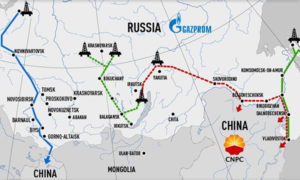
The potential pipelines that will be used to deliver Russian natural gas to China under the new deal signed by Gazprom and the China National Petroleum Corporation in May 2014
Source: RT/Gazprom
On 21 May 2014, on the sidelines of the Conference on Interaction and Confidence Building in Asia (CICA), Vladimir Putin and Xi Jinping looked on as Gazprom and the China National Petroleum Corporation signed an agreement for Russia to supply natural gas to China. The deal had been under negotiation for around a decade. Putin described the thirty-year, US$400 billion deal as ‘epochal’.
For Russia and China, who have long viewed each other as ideal energy partners, the mutual benefits appeared to be clear. Russia gained a new customer for its gas at a time when its relationship with the United States and Europe had become increasingly tense in the wake of Russia’s annexation of Crimea. China, meanwhile, is highly motivated to find sources of cleaner energy and the government had already pledged to more than double the country’s natural gas consumption by 2020.
Gazprom CEO Alexei Miller told the media in Shanghai that the deal is Gazprom’s biggest ever. Russian news agencies said the contract, calling for thirty-eight billion cubic metres of gas a year from 2018, specified a price of about US$350 per thousand cubic metres, which is at the low end of what Gazprom currently charges export customers.


